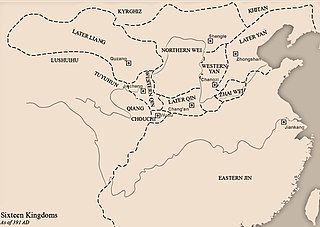
Tael, also known as the tahil and by other names, can refer to any one of several weight measures used in East Asia and Southeast Asia. It usually refers to the Chinese tael, a part of the Chinese system of weights and currency. The Chinese tael was standardized to 50 grams in 1959.

The cash was a currency denomination used in China in imperial times. It was the chief denomination until the introduction of the yuan in the late 19th century.

Wei, known in historiography as Zhai Wei, was a dynastic state of China ruled by the Dingling people that existed from 388 to 392, during the Sixteen Kingdoms period of Chinese history. Its founder Zhai Liao had previously been vacillating between being a vassal of the Later Yan, Western Yan, and Eastern Jin dynasties, and in 388, after his last overture to reconcile with Later Yan's emperor Murong Chui was rejected, he founded his own dynasty, over the territory of modern central and eastern Henan. In 392, Zhai Wei, then under Zhai Liao's son Zhai Zhao, was destroyed by Later Yan forces. Because of its relatively small size and short lifespan, Zhai Wei is not included by historians among the Sixteen Kingdoms.
The Yiwen Leiju is a Chinese leishu encyclopedia completed by Ouyang Xun in 624 under the Tang. Its other contributors included Linghu Defen and Chen Shuda.
Yujiulü Yucheng (?–485) was ruler of the Rouran (464–485) with the title of Shouluobuzhen Khagan (受羅部真可汗). He was the first Rouran ruler to adopt Chinese style era name, which was Yongkang. He was the elder son of Yujiulü Tuhezhen.
Yujiulü Doulan (?–492) was khagan of the Rouran (485–492) with the title of Fugudun Khagan (伏古敦可汗). He was the son of Yujiulü Yucheng.
Yujiulü Dengshuzi (?–555) was the last western khagan of the Rouran. He was a cousin of Anagui.
Yujiulü Tiefa was the successor to Yujiulü Anagui in the eastern part of Rouran. He was proclaimed khagan by remnants of Rouran in 552. But he ruled only briefly until his death at the hands of Khitans in February 553. He was succeeded by his father Yujiulü Dengzhu, who at first fled to Northern Qi following demise of Yujiulü Anagui. This was only case in Rouran history that a father succeeded his son on the throne.

The Battle of Shayuan was fought in 537 AD and was the second battle between the two successor states of Northern Wei during the Southern and Northern Dynasty period. During the battle, Yuwen Tai of Western Wei successfully ambushed and miraculously defeated the more than twenty times larger Eastern Wei army of Gao Huan that was marching towards Chang'an. The battle firmly established Western Wei's control of the Guanzhong Plain.
Wudai Huiyao is a Chinese historiography book on the Five Dynasties period of ancient China, written by the Song dynasty chancellor Wang Pu (922–982), who had personally served the last two of the five dynasties, namely the Later Han and the Later Zhou.
Sonom was a chieftain of the rGyalrong people in China. He was the lord-lama of Greater Jinchuan. He was executed after his January 1776 defeat in the Jinchuan campaigns.

The Shiben or Book of Origins was an early Chinese encyclopedia which recorded imperial genealogies from the mythical Three Sovereigns and Five Emperors down to the late Spring and Autumn period, explanations of the origin of clan names, and records of legendary and historical Chinese inventors. It was written during the 2nd century BC at the time of the Han dynasty.
Xuanhe Huapu is an 1120 Chinese palace catalog from the Song dynasty, which in 20 chapters categorized and described ~6396 paintings by 231 artists in the collection of Emperor Huizong of Song. "Xuanhe" (1119–1125) is an era name used by Emperor Huizong. The book is one of the most important sources about 11th/12th-century Chinese art, even if most paintings it described are no longer extant.
Wu Guo Gushi is a 10th-century Song dynasty history book, which in 2 chapters describes 5 of the southern states during the chaotic Five Dynasties period (907–960): the Wu, Southern Tang, Later Shu, Southern Han and Min Kingdom, especially their rulers. The author is unknown, but the book is considered unofficial. Emphasized in the book are court life, supernatural events and anecdotes.
Wang Cheng, courtesy name Jiping, was a Song dynasty historian who authored the monumental history book Dongdu Shilüe. He also published 4 volumes of poetry which are no longer extant.
Alp Bilge Qağan or Eletmiş Qağan — was a Basmyl chief who rebelled and brought Second Turkic Khaganate to an end.
Ashina Xian was a Western Turk khagan, also a general of Protectorate General to Pacify the West from 708 to 717, appointed by the Tang dynasty.
Duyizhi, a book in the genre of "transmissions of strange tales" (chuanqi), is now known only in partial form. The author has been identified as Li Rong. The book is a very important source for the modern study of Chinese mythology, containing many versions of otherwise lost narratives; such as the traditional story of Nüwa who mends the Heavens. The title (Duyizhi) has various translations into English, including Treatise on Extraordinary and Strange Things ; and, in Chinese transliteration as Tu yi chih. Of the original ten volumes of the Duyizhi, only three volumes survive.
Duke You of Lu, personal name Ji Zai (姬宰) or Yi (懌), was the fourth ruler of the state of Lu, reigning for a total of 14 years. He inherited the duchy from his father, Duke Yang.
Zhaoli Qaghan (昭禮可汗) was tenth ruler of Uyghurs. His personal name was recorded as Yaoluoge Hesa (藥羅葛曷薩) in Chinese sources. His Uyghur name could be Qasar or Xazar.




